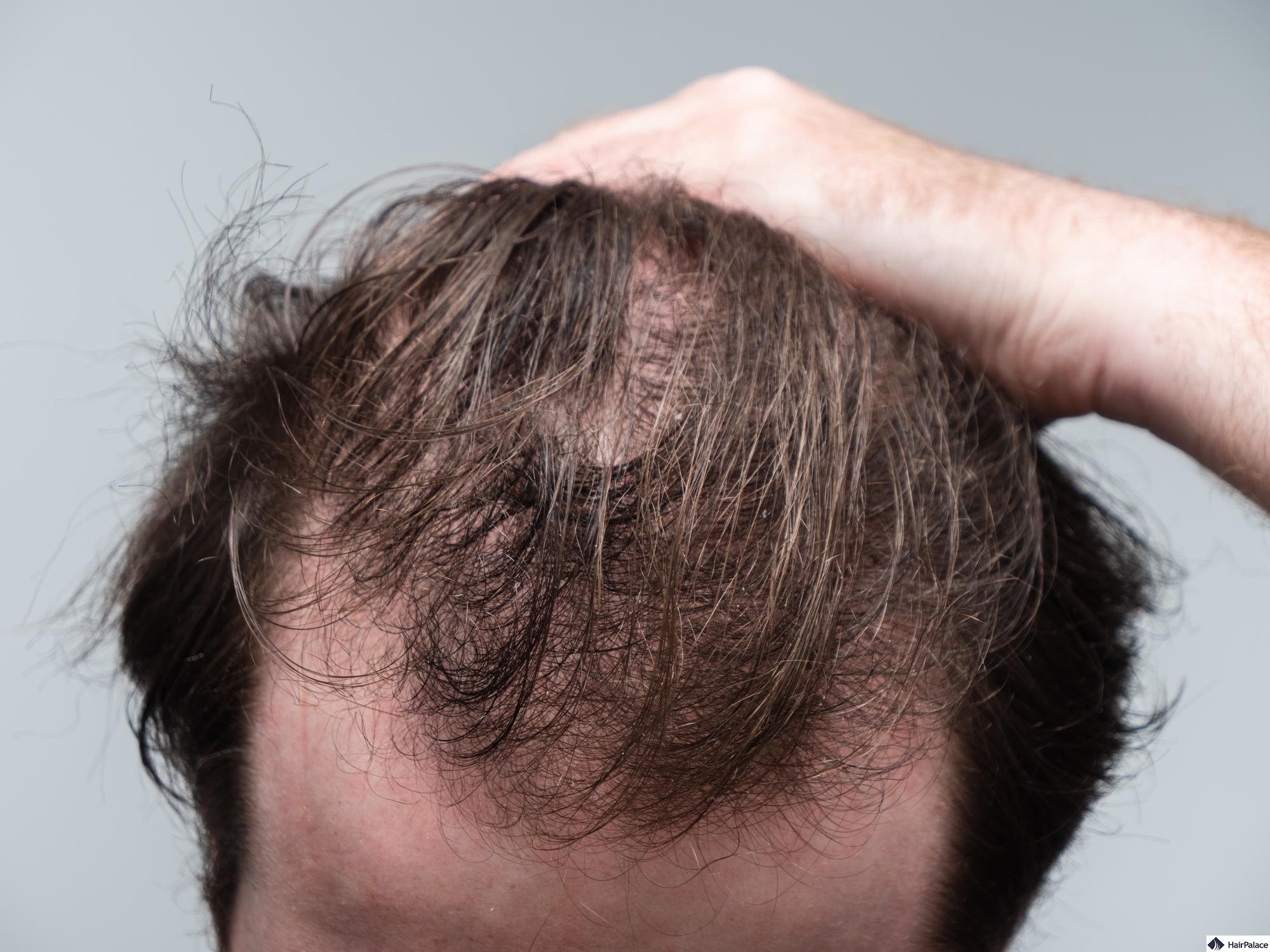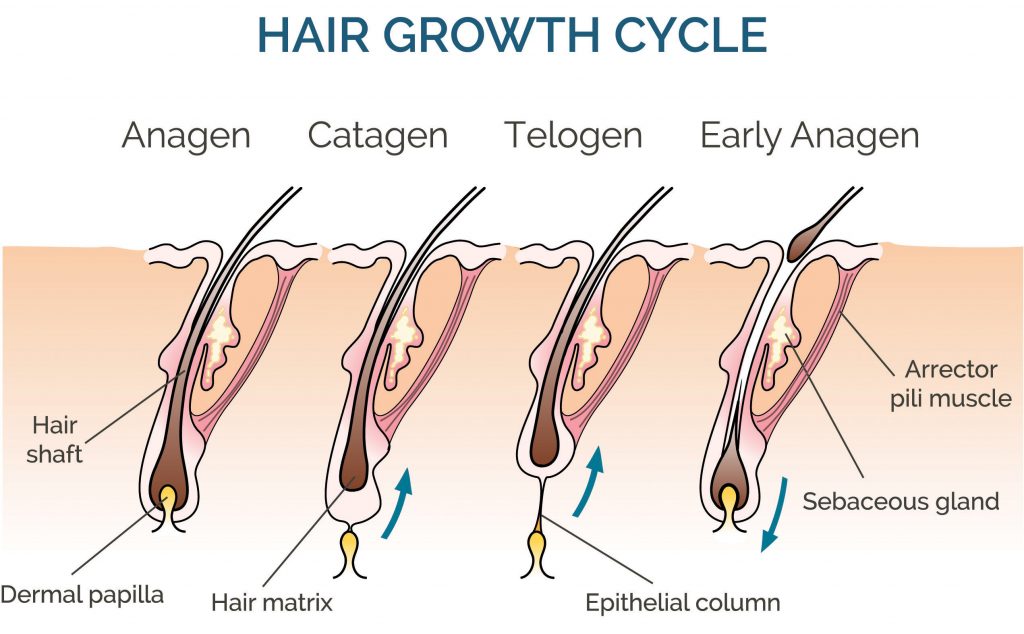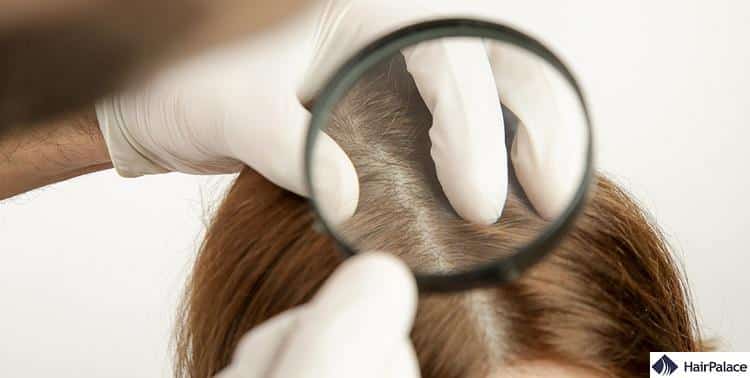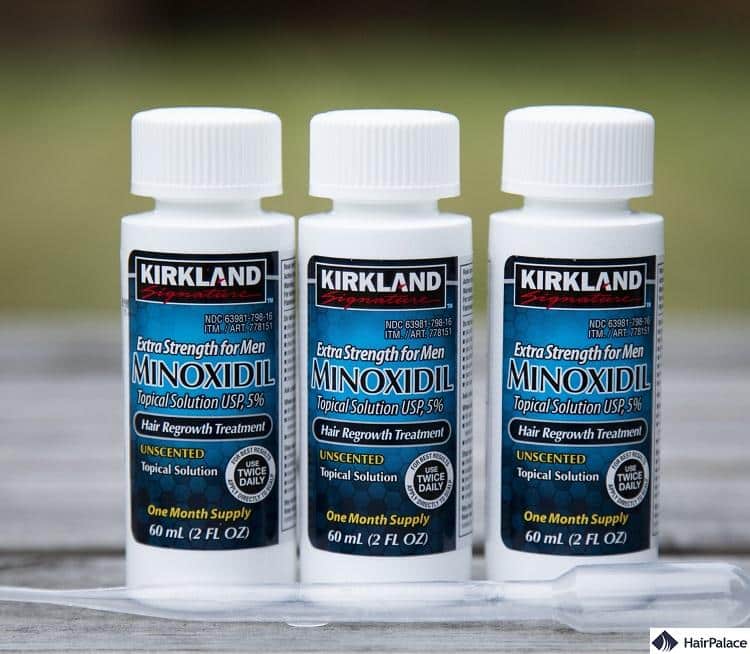Telogen Effluvium: Causes, Symptoms, and Treatments

Telogen effluvium is a temporary form of hair loss that occurs when a significant number of hair follicles enter the resting (telogen) phase simultaneously.
This condition is often triggered by factors such as stress, illness, hormonal changes, or nutritional deficiencies.
Hair shedding typically begins a few months after the triggering event and can last for several months.
While it is normal to lose 50-100 strands each day, this condition can cause as many as 300 hairs to fall out daily.
In this article, we will take a look at the potential causes, symptoms, and available treatment options.
What is telogen effluvium?
Telogen effluvium is a form of diffuse non-scarring alopecia with an abrupt onset, it’s characterized by increased shedding or hair thinning.
Women have a higher chance of experiencing it, and the condition is usually triggered by a disruption to the normal hair cycle.
The hair growth cycle has four separate stages
- Anagen or “growth phase”
- Catagen or “transitional phase”
- Telogen or “resting phase”
- Exogen or “shedding phase”

As the name suggests, this condition is associated with the telogen phase.
On average 5 to 10% of our hair follicles are in this telogen “resting phase” at any given time.
Telogen effluvium causes the anagen phase to slow down, which leads to fewer hairs entering the next stages.
Telogen hairs make up about 30% of all hair for people with this condition, the unusual number of hair follicles staying in this resting phase leads to sudden and excessive shedding.
Thankfully, the condition typically only causes temporary hair loss, although the hair can become noticeably thinner.
What is acute telogen effluvium?
Acute telogen effluvium is defined as hair shedding lasting for less than 6 months.
The condition doesn’t cause any inflammation but may affect up to 50% of scalp hairs.
At first, the resting club hairs stay firmly attached to the telogen follicles.
However, as new hairs come up through the scalp, they slowly push out the resting club hair.
Generally, people notice diffuse hair loss around 3 months after the triggering event.
Strangely, the shedding that occurs with this condition signals the appearance of new anagen hair.
- Patients may notice a fine fringe of new hair along the forehead hairline, as the new hairs come up through the scalp and push out the dead telogen hair.
- In the beginning, the fall of dead hair is profuse, but the condition reaches a peak after a couple of months and the hair fall slowly begins to moderate with hair regrowth occurring over a 6 to 9-month period.
- As the hair fall slows down, hair thickness returns to normal as well. Although the recovery may not be complete in certain cases.
What is chronic telogen effluvium?
We talk about chronic telogen effluvium if a person repeatedly experiences hair shedding for a period exceeding 6 months.
This condition can be stressful and scary, but it is fully reversible in most cases.
In some occurrences, the general thinning continues for years instead of just a few months.
In these instances the cycle resets and the scalp hair returns to the anagen phase, but only for a short time before it gets pushed into the telogen phase again.
Chronic telogen effluvium often affects women who continue to have long and thick hair, this is mainly because as the hairs fall their appearance goes through a more dramatic change which is easier to notice.
Telogen effluvium patients rarely lose all their hair, but the condition can shed light on genetic balding such as female or male pattern baldness.
The exact mechanism of chronic telogen effluvium is still being explored.
Many women with a long case of telogen effluvium who experience widespread shedding have completely normal hormonal studies.

Causes of telogen effluvium
TE hair loss can develop due to multiple different causes:
1. Severe stress
High-stress periods caused by surgery, a major stressful event, or physical illnesses can trigger telogen effluvium.
The reason is simple: hair is not essential for human survival, so all energies are channelled into repairing critical structures within the body instead.
Hair loss may not become noticeable until around 3 months after the stressful event, and new hair growth could take 3 months after the stressful period ends.
2. Poor diet
A nutritional deficiency can have a negative effect on hair growth.
Eating programs created or supervised by a physician have become popular, as are supplements and vitamins.
However, vitamins can’t prevent shedding that occurs when an individual loses a lot of weight in a short period.
Any supplements rich in vitamin A may exacerbate the problem, too.
3. Medications
Certain medications, such as mounjaro, and some antidepressants, antihypertensives, and contraceptives can cause TE.
4. Sudden weight loss
Major weight loss or a heavy calorie restriction can result in increased hair shedding.
5. Pregnancy
While you’re pregnant you have far more anagen hair than an average person.
However, after about 3 to 6 months of giving birth, your body goes through major hormonal changes.
The excess hair that stayed in the anagen phase suddenly moves into the resting phase.
This type of diffuse hair shedding is called post-partum hair loss.
6. Menopause
The hormonal changes that happen in post-menopausal women can also lead to telogen effluvium.
7. Metal toxicity
Repeated contact with toxic chemicals found in certain metals can lead to a loss of hair strands.
8. Health conditions
Some underlying health conditions such as autoimmune diseases, alopecia areata, and issues with the thyroid gland can cause hairs to fall out.
Symptoms of telogen effluvium
Telogen effluvium symptoms can take various forms the most common ones include:
- diffuse thinning, which may be uneven
- sudden increase in hair fall
- the top of the scalp thins more than the sides and the back
- no hairline recession
- there is a small keratin bulb on the roots of the shed hairs
In severe cases, telogen effluvium may cause hair loss at the hairline and other parts of the body, such as the eyebrows and pubic hair.
How is telogen effluvium hair loss diagnosed?

Telogen effluvium is usually diagnosed by carrying out clinical and diagnostic research on the hairs that have fallen out.
There are several tests used by healthcare professionals to diagnose telogen effluvium:
- Examining the length and diameter of shed hairs can reveal a lot about their condition, and may allow a doctor to differentiate between this and androgenetic alopecia.
- A hair pull test can be carried out to see how much hair is being shed.
- A wash test can be carried out where the number of lost hairs during washing is counted.
- A simple blood test can also be useful to reveal the cause of the shedding. These tests may show an iron deficiency or reveal thyroid issues.
Specific treatment exists to resolve the thinning caused by telogen effluvium.
It is important to turn to a dermatologist for advice, as they can examine the state of your hair, and scalp and diagnose the type of hair loss you’re experiencing.
Telogen effluvium treatment
The treatment for telogen effluvium in male patients largely depends on the root cause.
As soon as the cause has been established and dealt with, your hair cycle should normalize and the hair will start to grow back. Typical treatment options include:
Dietary changes to resolve any nutritional deficiencies
You may be deficient in some essential vitamins and nutrients that are important to hair health.
Ask your doctor to check your levels and see if you are getting enough vitamin D, zinc, and iron.
Eating a well-balanced diet is crucial to ensuring you get all of the nutrients you need.
Minoxidil to stimulate the hair follicles
OTC products may also help regrowth. Be sure to select a product that contains 5% minoxidil.
This is a once-daily topical product that’s applied directly to the scalp.
It works by prolonging the anagen, or the active growth phase of the hair follicle.

Hormone therapy for women going through the menopause
If your hair loss is related to stress, reducing your stress levels may also help.
You may wish to start journaling or mindful meditation to help manage your stress.
Yoga and other forms of exercise may help clear your mind and offer a healthy way to cope with your stress.
Gentle hair care
If you have telogen effluvium and itchy scalp, you must be gentle when styling your hair.
Avoid blow drying, straightening, or curling your hair until your condition improves.
You should also avoid treating your hair with chemicals, as dyes and bleaches can damage the hair follicle and inhibit growth.
What does telogen effluvium regrowth look like?
TE hair loss isn’t permanent; regrowth usually occurs after removal of the trigger causing telogen effluvium.
Although your hair will continue its regular growth pattern within 6 months, it may take 12 to 18 months before your hair regains its previous appearance fully.
Alopecia areata or telogen effluvium: How to tell the difference?
There are several key differences between these two conditions.
Alopecia areata results in well-defined round or oval-shaped bald patches.
On the other hand, telogen effluvium leads to diffuse hair thinning across the scalp without clear bald spots.
One is typically caused by an autoimmune condition, while the other is triggered by stress, illness, or hormonal imbalances.
Thankfully, both conditions are non-scarring types of hair loss, which means regrowth is often possible without treatment.
Conclusion
Telogen effluvium is a common cause of temporary hair loss.
It is characterized by an abrupt onset of hair fall usually seen several months after a triggering event.
While no specific treatment exists, addressing the cause and implementing lifestyle and dietary changes can be effective in beginning hair regrowth.
Telogen effluvium is not the only potential cause of thinning hair:
Telogen Effluvium FAQ
Hair thinning that occurs due to TE may grow back within three to six months of treatment. The amount of hair loss may decrease in some cases but won’t stop completely. Generally, 50% or less of hair falls out.
Losing more hair than usual is an obvious sign of TE. People lose between 50 and 100 hairs per day on average, but this may increase if you have a severely stressful experience. Symptoms can appear three or four months following the incident.
TE doesn’t cause complete baldness in most cases, though you may lose 300 – 500 hairs each day. This condition can be the result of childbirth, a fever, a medical issue, a thyroid imbalance, or invasive surgery.
To stop TE, address the underlying cause: reduce stress, ensure a balanced diet with adequate nutrients, manage any hormonal imbalances, and avoid harsh hair treatments. If an illness or medication is the cause, consult a healthcare professional for appropriate management. Recovery typically occurs naturally over time.
Typically, TE is a temporary condition lasting several months. However, in some cases, particularly when the triggering factor persists or in chronic telogen effluvium, it can last for years.
Yes, TE can sometimes change hair texture, making regrown hair feel finer or different from the original hair.
This condition causes diffuse hair shedding, often making areas like the hairline appear thinner. However, it typically doesn’t cause permanent hair loss, and hair usually regrows once the underlying cause is addressed.
Telogen effluvium typically does not cause a receding hairline in the traditional sense, as it leads to diffuse hair shedding rather than patterned hair loss. However, significant thinning at the hairline may give the appearance of a receding hairline. Unlike androgenetic alopecia, which permanently alters hair growth in specific areas, telogen effluvium is usually temporary, and hair regrowth occurs once the triggering factor is resolved.
Telogen effluvium can affect the crown, as it causes diffuse hair shedding across the scalp, including the crown area.
Telogen effluvium regrowth appears as short, fine, baby-like hairs, often referred to as “peach fuzz.” These new hairs gradually thicken and blend with the rest of the hair as they grow longer.
Last medically reviewed on April 25th, 2025
- Aziz, A. M. A., Hamed, S. S., & Gaballah, M. (2015, July). Possible relationship between chronic telogen effluvium and changes in lead, cadmium, zinc, and iron total blood levels in females: A case-control study. International Journal of Trichology, 7(3), 100–106https://www.ncbi.nlm.nih.gov/pmc/articles/PMC4639951/
- Golouch-Koniuszy, Z. S. (2016, March). Nutrition of women with hair loss problem during the period of menopause. Menopause Review, 15(1), 56–61https://www.ncbi.nlm.nih.gov/pmc/articles/PMC4828511/
- Rebora, A. (2017, March). Intermittent chronic telogen effluvium. Skin Appendage Disorders, 3(1), 36–38https://www.ncbi.nlm.nih.gov/pmc/articles/PMC5465665/
- Malkud, S. (2015, September). Telogen effluvium: A review. Journal of Clinical and Diagnostic Research, 9(9), 1–3https://www.ncbi.nlm.nih.gov/pmc/articles/PMC4606321/pdf/jcdr-9-WE01.pdf
- Burgdorf W. (2009). Braun-Falco’s dermatology (p. p648). Heidelberg: Springer.
- Bolognia JL, Jorizzo JL, Schaffer JV. (2012). Dermatology: 2-Volume Set: Expert Consult Premium Edition-Enhanced Online Features and Print, 3e (Bolognia, Dermatology).


